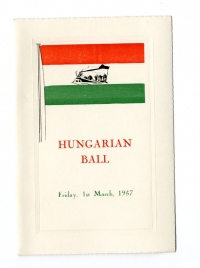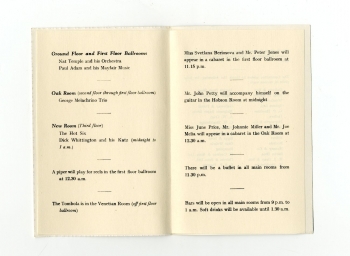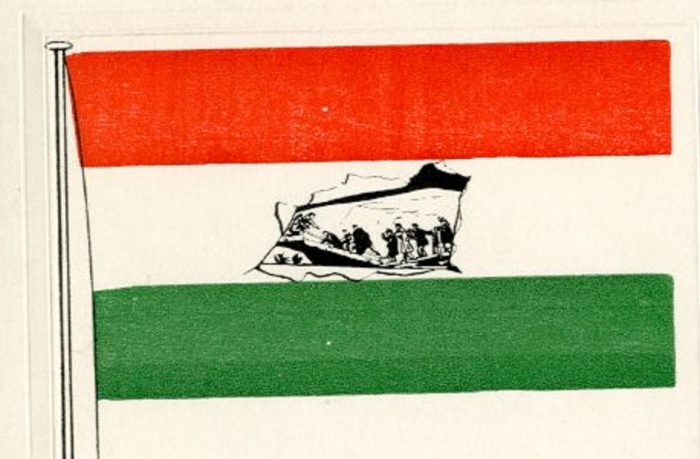The St. John's Hungarian Ball, 1957
In the early hours of the 4th November 1956, Soviet tanks thundered through the streets of Budapest. Their objective was to seize power of the capital and bring Hungary back under Soviet control, after several weeks’ worth of intense social unrest, a nationwide revolt, and the instigation of a new liberal Hungarian government (directed by Imre Nagy) in October 1956. Orders for the attack on Budapest came only days after the then leader of the Soviet Union, Nikita Khrushchev, had agreed to the request of Nagy’s government to withdraw Russian troops from the city. But in the fierce conflict that followed, Soviet forces quashed the revolution, crushing the resistance not only of the Hungarian Army, but also of the many civilians who fought to protect the city from external forces.
The consequences of the 1956 Hungarian uprising and its suppression were devastating. It is estimated that as many as 4000 Hungarians were killed, with thousands more subsequently arrested, imprisoned and executed. Horrified by what had happened, Western powers poured financial aid and resources into supporting the estimated 200,000 refugees who fled Hungary in the months that followed. In Britain alone, an initial quota of 2500 refugees was quickly revised by the government and increased to 12,000 in order to cope with the huge influx of people. By the 9th January 1957, two million pounds had been given to the Lord Mayor’s Fund in order to help those arriving into Britain from Hungary.
Among the Hungarian refugees who came to Britain were around 500 university students, for whom British universities (including Oxford, London, Leeds, Birmingham, Edinburgh and Cambridge) willingly agreed to provide support in the form of temporary accommodation, intensive language courses, and scholarships that would enable them to complete their studies. King’s College and Trinity College were the first to welcome Hungarian students to Cambridge, with many other colleges following soon after.
 The programme featured here, taken from the collections of the St. John’s College Archive Centre, offers a small but intriguing connection to the events of the Hungarian Revolution and its aftermath sixty years ago. Designed for the College’s Hungarian Ball, which took place on the 1st March 1957, it contains details of the evening’s entertainment, with notable performances by Nat Temple and his Orchestra, the George Melachrino Trio, and a cabaret which involved a piece by the Lithuanian-born British prima ballerina, Svetlana Beriosova (1932-1998).
The programme featured here, taken from the collections of the St. John’s College Archive Centre, offers a small but intriguing connection to the events of the Hungarian Revolution and its aftermath sixty years ago. Designed for the College’s Hungarian Ball, which took place on the 1st March 1957, it contains details of the evening’s entertainment, with notable performances by Nat Temple and his Orchestra, the George Melachrino Trio, and a cabaret which involved a piece by the Lithuanian-born British prima ballerina, Svetlana Beriosova (1932-1998).
Sadly, as the only evidence we have for the Ball, the programme gives scant information concerning the context for the event, although from what we know, it is possible to suppose that the Ball was organised in aid of refugees, or else perhaps as an official welcome for new Hungarian students staying at St. John’s.
If we look closely at the front cover, we can see the Hungarian national flag with the central 1949-1956 coat of arms removed – a gesture of solidarity with the Hungarian freedom fighters for whom this altered version of Hungary’s flag became a symbol of anti-Soviet feeling. In this particular instance, the coat of arms has been replaced by a black-and-white miniature drawing that depicts refugees climbing onto a raft-like object. The framed outline of the drawing mirrors the shape of Hungary. As a poignant portrayal of ordinary individuals fleeing persecution, the image both captures the mood of a specific historical moment and speaks to the tragedy of the ongoing refugee crisis of present times.
For further information about the experience of Hungarian student refugees at British universities, please see “Just Like Other Students”: Reception of the 1956 Hungarian Student Refugees in Britain by Magda Czigány (Cambridge, 2009).
Were you present at the Ball in 1957? If so, we would love to hear from you. See http://www.joh.cam.ac.uk/archives-visiting-contact for details about how you can get in touch.
This article was contributed by Eleanor Swire

